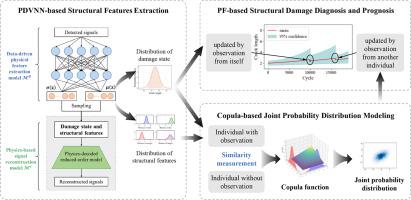考虑个体结构特征相似性的数字孪生舰队结构损伤诊断与预后
IF 5.8
1区 工程技术
Q1 ENGINEERING, AEROSPACE
引用次数: 0
摘要
基于在线监测数据的结构健康状态诊断和预测对于实现基于状态的维修和确保航空结构的安全至关重要。然而,现有的大多数研究都侧重于个体水平的结构损伤诊断和预后,往往忽视了利用整个船队数据的潜力,这需要准确测量船队中个体之间结构之间的相似性和损伤状态的相关性。为了解决这个问题,我们提出了一种利用单个结构特征的相似性进行舰队级结构损伤诊断和预后的新方法。该方法引入了物理解码变分神经网络,能够准确提取结构特征并量化损伤。此外,基于结构特征相似性度量,采用copula函数对不同结构间损伤状态的联合概率分布进行建模。这种方法允许在诊断过程中使用单个结构的观察数据来协作更新整个船队的损伤状态。在一个典型的航空损伤面板上的验证表明,与传统的基于个体的方法相比,该方法可以更准确地诊断和预测机队中单个结构的损伤状态,同时减少了服役期间的不确定性。该方法有望集成到机队级别的机身数字孪生框架中,从而推进机队状态维护的实施。本文章由计算机程序翻译,如有差异,请以英文原文为准。

Structural damage diagnosis and prognosis with fleet digital twin considering similarity of individual structural features
Diagnosis and prognosis of the structural health state based on online monitoring data is crucial for enabling condition-based maintenance and ensuring the safety of aeronautical structures. However, most existing studies focus on structural damage diagnosis and prognosis at the individual level, often overlooking the potential of utilizing fleet-wide data, which requires accurately measuring the similarity between structures and the correlation of damage states across individuals in the fleet. To address this, we propose a novel method for fleet-level structural damage diagnosis and prognosis that leverages the similarity of individual structural features. The method introduces a Physics-Decoded Variational Neural Network, enabling accurate extraction of structural features as well as quantifying damage. Additionally, a copula function is used to model the joint probability distribution of damage states across different structures, based on structural feature similarity metrics. This approach allows for collaborative updating of damage states across the fleet using observations from individual structures during the diagnosis process. Validation on a typical damaged aeronautical panel demonstrates that the proposed method achieves more accurate diagnosis and prognosis of individual structural damage states within a fleet, while reducing uncertainties during service compared to conventional individual-based approaches. This method shows promise for integration into a fleet-level airframe digital twin framework, advancing the implementation of condition-based maintenance across fleets.
求助全文
通过发布文献求助,成功后即可免费获取论文全文。
去求助
来源期刊

Aerospace Science and Technology
工程技术-工程:宇航
CiteScore
10.30
自引率
28.60%
发文量
654
审稿时长
54 days
期刊介绍:
Aerospace Science and Technology publishes articles of outstanding scientific quality. Each article is reviewed by two referees. The journal welcomes papers from a wide range of countries. This journal publishes original papers, review articles and short communications related to all fields of aerospace research, fundamental and applied, potential applications of which are clearly related to:
• The design and the manufacture of aircraft, helicopters, missiles, launchers and satellites
• The control of their environment
• The study of various systems they are involved in, as supports or as targets.
Authors are invited to submit papers on new advances in the following topics to aerospace applications:
• Fluid dynamics
• Energetics and propulsion
• Materials and structures
• Flight mechanics
• Navigation, guidance and control
• Acoustics
• Optics
• Electromagnetism and radar
• Signal and image processing
• Information processing
• Data fusion
• Decision aid
• Human behaviour
• Robotics and intelligent systems
• Complex system engineering.
Etc.
 求助内容:
求助内容: 应助结果提醒方式:
应助结果提醒方式:


